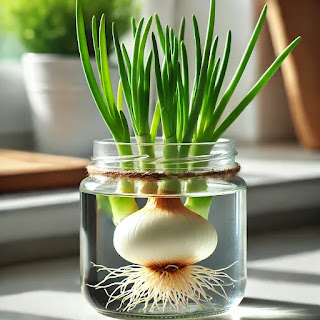Have you ever thought that the food scraps you usually throw away could become a source of new plants?
This practice is known as regrowing, which means growing new plants from food scraps. Not only does it reduce waste, but regrowing also provides many benefits for you and the environment. Here’s how to get started easily and the advantages you can gain from doing it.
Easy Steps to Regrow from Food Scraps
Green Onions
- Steps: Cut the root end of the green onions and place it in a container with a little water, ensuring the roots stay submerged. Put it in a spot with sunlight. Within a few days, you’ll see new green shoots.
- Benefit: You won’t need to buy green onions as often. The regrown green onions can be continuously harvested and used in various dishes.
Lettuce and Bok Choy
- Steps: Cut the bottom part of the lettuce or bok choy, about 1-2 inches from the root. Place it in a shallow dish with a little water. In a few days, new leaves will sprout, and you can transfer it to soil for further growth.
- Benefit: Save money and always have fresh lettuce or bok choy at home.
Garlic
- Steps: Take a few cloves of garlic that have begun to sprout and plant them in a small pot with soil. Place it in a sunny spot, water regularly, and within a few weeks, you’ll have new garlic bulbs.
- Benefit: Enjoy fresh and healthy garlic grown right at home.
Potatoes
- Steps: Cut potatoes that have eyes or sprouts into sections, ensuring each piece has at least one eye. Let the pieces dry for a few hours, then plant them in soil. Within a few weeks, potato plants will begin to grow.
- Benefit: Harvest fresh potatoes that are tastier and more nutritious.
Does the Nutritional Value of Regrown Plants Decrease?
One common question is whether the plants grown through regrowing have the same nutritional content as the original plants. Generally, the answer is yes—the nutritional content of regrown plants is usually the same or very similar to the original plants. However, some factors can influence this:
Quality of Soil and Water: If the regrown plants receive sufficient nutrients from nutrient-rich soil or water, their nutritional content will remain optimal. On the other hand, if the growing medium is less fertile, the nutrients may decrease.
Sunlight Exposure: Plants need sunlight for photosynthesis, which is crucial for their growth and nutritional quality. Plants that do not get enough light may have lower nutritional content.
Growth Stage: In some cases, plants grown from food scraps may not reach the same size or maturity as the original plants, which can affect their nutritional content. However, this is more related to the quality of growth than the regrowing method itself.
With proper care—such as providing fertile soil, adequate water, and sunlight—you can ensure that the nutritional content of regrown plants remains comparable to those grown from seeds.
Benefits of Regrowing from Food Scraps
Reducing Household Waste
- Regrowing is one of the most effective ways to reduce organic waste at home. Instead of throwing away food scraps, you can give them a new life.
Cost Savings
- By utilizing food scraps to regrow plants, you can save on daily expenses for purchasing vegetables or herbs.
Supporting Sustainability
- Reducing waste and growing your own plants is a small step that can have a big impact on the environment. It helps maintain ecological sustainability and reduce carbon footprints.
Enhancing Quality of Life
- Growing and caring for your plants can be a fun and relaxing activity. Additionally, the harvest from regrowing is often fresher and richer in nutrients.
Through these simple steps, you can not only reduce waste but also gain various benefits for yourself and the environment. Happy regrowing!



No comments:
Post a Comment